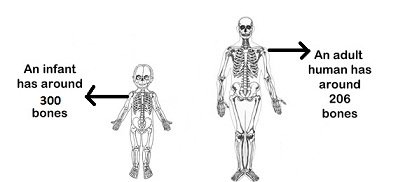The human body is a fascinating and intricate marvel of nature, and the skeletal system forms its sturdy framework. As parents and caregivers, understanding the development of a child’s skeletal structure is crucial for their overall health and well-being. In this article, we delve into the intriguing question: How many bones are there in a child’s body?
How Many Bones in a Child? A child is born with about 270 bones in his or her body. During growth, some of the bones fuse to leave the average adult with 206 bones. This process is purely natural and, therefore takes place to favor development, giving a body structure that supports movement and protection.
| Category | Description | |
|---|---|---|
 | Newborn Bones Count | A baby is born with about 300 bones most of which are made of cartilage. |
| Ossification | The process by which cartilage gradually changes into bone as the child grows. | |
 | No Longer Child Bones | As children grow their bones fuse together reducing the count to 206 in adulthood. |
| Nutrient Requirements | Calcium containing foods essential for bone growth are dairy, fish and leafy green vegetables. | |
| Key Elements | Genetics, diet plan and physical activity play a vital role in bone health! |
When a child is born, their journey toward building a complete skeletal system commences. At the moment of birth, a newborn possesses around 300 bones. These bones, in the early stages, are predominantly composed of cartilage, which is a pliable and rubbery connective tissue. Cartilage serves as a temporary scaffold for the developing skeleton and provides flexibility during the initial phases of growth.

As the child progresses through infancy and childhood, the process of ossification takes center stage.
What is Ossification?
Ossification is the natural biological process by which cartilage or soft connective tissue gradually transforms into bone. This intricate and essential mechanism plays a crucial role in the development and maturation of the skeletal system in humans and other vertebrates.

Here is a step-by-step breakdown of the ossification process:
1.Formation of Cartilage Scaffold:
Before ossification begins, the embryonic skeleton is primarily composed of cartilage, a flexible and rubbery connective tissue. This cartilaginous scaffold serves as a temporary framework that allows for the initial formation and growth of bones.
2.Deposition of Minerals:
As the skeletal system develops, certain cells within the cartilage, known as osteoblasts, initiate the deposition of minerals onto the cartilage matrix. The key minerals involved in this process are calcium and phosphorus. These minerals gradually accumulate and adhere to the cartilage, causing it to harden and become more rigid.
3.Formation of Bone Tissue:
The deposition of minerals triggers the transformation of cartilage cells into osteocytes, which are mature bone cells. These osteocytes become embedded in the calcified matrix, forming the dense and solid structure characteristic of bone tissue.
4.Blood Vessel Invasion:
Ossification is often associated with the invasion of blood vessels into the developing bone tissue. Blood vessels bring in oxygen and nutrients essential for the continued growth and mineralization of the bone.
5.Bone Growth and Remodeling:
Ossification is not a one-time event but rather an ongoing process throughout life. In growing individuals, bones continue to lengthen and thicken through the activity of growth plates, which are areas of cartilage at the ends of long bones. Additionally, bones undergo remodeling, a process where old or damaged bone tissue is replaced by new, healthy bone tissue.
There are two main types of ossification:
Intramembranous Ossification:
This type of ossification occurs within membranes and is responsible for the formation of flat bones, such as those in the skull.

Endochondral Ossification:
This type involves the replacement of cartilage by bone and is responsible for the formation of most of the bones in the body, including long bones like the femur and humerus.

The Adult Skeleton
The number of bones in a child’s body is greater than that of an adult. As a child grows, certain bones fuse together, resulting in an average adult skeleton consisting of 206 bones. However, the exact number can vary slightly from person to person due to genetic factors and individual differences in bone structure.
Nutritious foods that are beneficial for the bone health of children include:
Dairy Products: Foods like milk, yogurt, and cheese are rich in calcium, which is essential for bone growth and strength.
Leafy Green Vegetables: Spinach, kale, and broccoli are good sources of calcium and other vital nutrients for bone health.
Fish: Fatty fish like salmon and tuna are not only high in protein but also contain vitamin D, which helps in calcium absorption.
Soy Products: Tofu and soy milk are fortified with calcium and can be a great alternative for those who are lactose intolerant.
Nuts and Seeds: Almonds, sesame seeds, and chia seeds provide calcium and healthy fats that are good for bone development.
Whole Grains: Some bread and cereals are fortified with calcium and other nutrients beneficial for bone health.
Ensuring a balanced diet that includes these foods can help children develop strong and healthy bones.

What is Child Labour?How Can It Be Prevented?
Factors Influencing Bone Development
Several factors influence the development of a child’s bones. Nutrition plays a crucial role, as a balanced diet rich in calcium, phosphorus, and other essential minerals is essential for healthy bone growth. Regular physical activity also contributes to bone density and overall skeletal health.

